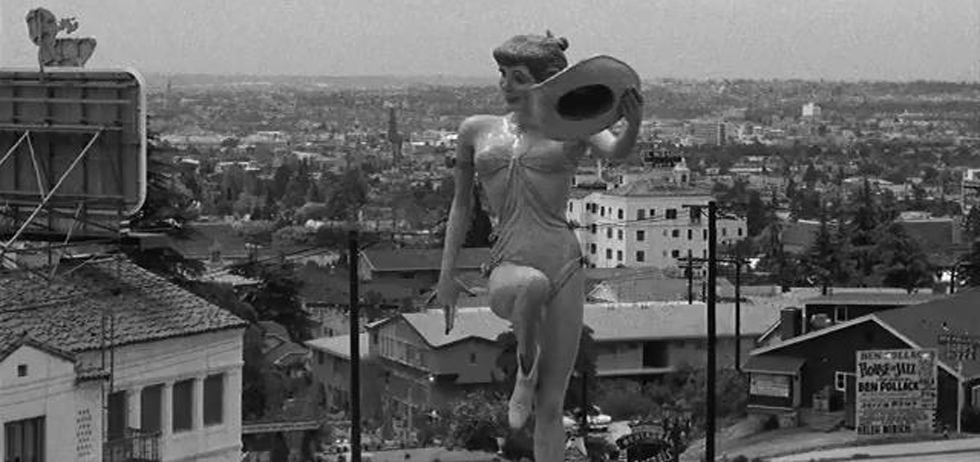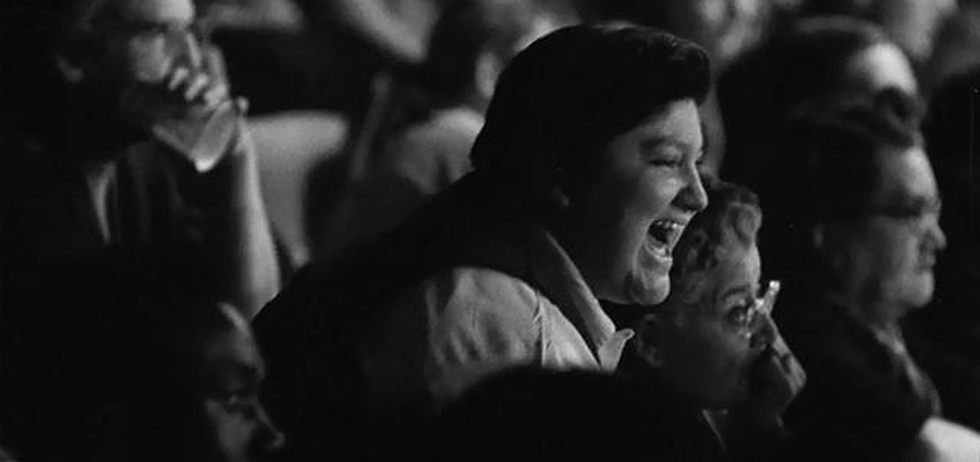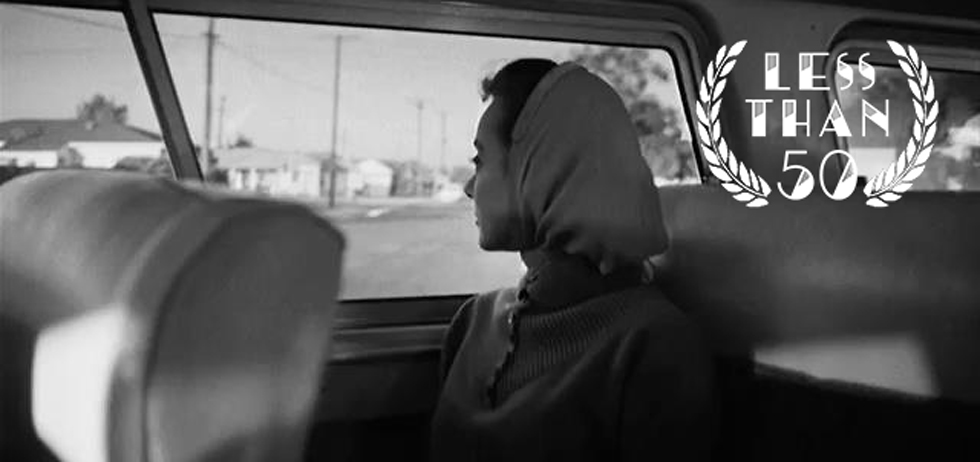In our regular column, Less Than (Five) Zero, we take a look at films that have received less than 50 logged watches on Letterboxd, aiming to discover hidden gems in independent and world cinema. This week Conor Bateman looks at the independent hybrid fiction-documentary The Savage Eye.
Date Watched: 18th March, 2015
Letterboxd Views (at the time of viewing): 15
“Virgins and mysteries. The truth concealed in plaster.”
It should come as no surprise that there are a lot of cinephiles on Tumblr, but recently one way I’ve been attuned to rare and unusual cinema is through two Tumblrs in particular, The Least Reputable Cinephile and shining wizard, both of which amount to film logs, where each blogger lists the film they saw, some stills, and a rating. What makes these Tumblrs particularly compelling is that, more often than not, the films they see are either very hard to find, or unusual in some way. The Savage Eye came to my attention via this post, just a series of stills from the film, but most of which are captivating in some manner. Even the first one, a seemingly simple shot of a woman at a mirror, suddenly gains weight once you notice that it’s a crossfade, the gaze of the woman now threefold. Its framing is striking and well composed, its faux cinema verite style reminded me, at least initially, of the first film we covered for Less Than (Five) Zero, Kazuo Kuroki’s Silence Has No Wings.
The Savage Eye is something of a different beast, though. Whilst it shares some of the pseudo-documentary stylings of the crowd work in Silence Has No Wings, its approach to voiceover and character is wholly unique. What Ben Maddow, Sidney Meyers and Joseph Strick have crafted is a bleak and unusual film which savagely attacks the banality of existence in 1950s America, as seen through the eyes of a newly divorced woman (Barbara Baxley, brilliant here) who wants time to just pass her by. It’s primarily unusual in the way it acts as something caught between the cracked divide of documentary and fiction. Its diegetic dialogue-free narrative is cut into a documentary of landscape and people, the filmmakers deftly applying social commentary to the faces of innocent bystanders, whose genuine actions seem to perfectly reflect the depressive inner monologue of our protagonist; shouting crowds become animalistic spectacle, target for our derision.
The filmmakers themselves come from disparate backgrounds. Ben Maddow was an acclaimed screenwriter, having been nominated for an Academy Award for John Huston’s 1950 noir classic The Asphalt Jungle. Sidney Meyers was a documentarian and editor (for both film and television) who edited Martin Ritt’s debut, Edge of the City in 1957 and who also garnered an Oscar nomination in 1948, for his documentary The Quiet One.1 Joseph Strick is perhaps the most interesting of the bunch, not so much for his legacy as his odd filmography. In a piece for Film Quarterly, Benjamin T. Jackson wrote about Strick’s introduction to film, by way of wealth – “…luckily he had money: Strick is a very wealthy and intelligent businessman who owns a controlling interest in several large electronic corporations”. He began with 1948’s Muscle Beach, an experimental short he made with filmmaker Irving Lerner assisting, and much of that film’s documentary aesthetic and approach would be mirrored in The Savage Eye. Later in his career, though, he moved away from documentary towards a polar opposite, literary adaptations. He made two adaptations of the work of James Joyce, Ulysses in 1967 (which was infamously banned in Australia!) and A Portrait of the Artist as a Young Man a decade later, in addition to the widely derided adaptation of Henry Miller’s Tropic of Cancer (1970).2

The film seems grounded in the cadence of the noir, and not only because the title feels like a precursor (or follow-up) to The Naked Kiss. In addition to the cinematography (by the legendary Haskall Wexler, along with Jack Couffer and Helen Levitt) much of the duologue narration is sharp and funny, whilst directly addressing the idea of a long-gestating depression. Gary Merrill’s voice-only performance as “The Poet” (i.e. Judy’s subconscious) is an impressive and amusing foil, his assured and authoritative tone a one-note run that highlights the subtleties of Baxter’s performance; Jonathan Rosenbaum likened their patter to “T.S. Eliot strained through pulp.” The schtick of the dialogue, though, occasionally moves into the realm of near-parody, most often when the filmmakers too obviously enforce their thematic drive, such as a scene in a strip club that mainly serves to underline the lustful desires of Judy’s ‘companion’.3 That said, though, there’s a wealth of gems in the film, including this early exchange, which featured on the film’s theatrical poster:
The Poet: “What’s your name?”
Judy: “Judith.”
P: “Judith what?”
J: “Judith X.”
P: “What’s the X?”
J: “Ex-McGuire. I’m divorced.”
It’s a bleak joke that also positions the film as being firmly within her worldview. We look at ‘the city’ (Los Angeles in faint disguise) with an intentionally undeveloped disdain. Rosenbaum, again, also noted much of the dialogue in the film carries an air of “lapsed Catholicism”, which is a perfect comparison, the film feeling like a rejection of society in pretense, with the underlying hatred of the self pushing out from under the lashing out at people in general.4 There’s also a solid masturbation joke in the film as well, so lapsed Catholicism abounds.
One of the more captivating sequences in the film directly involves religion, shot in a church during mass. A relatively long segment, it seems to savagely indict the idea of religion as salvation, the father-as-healer moving through each member of the congregation mechanically, reciting a variation on the same few lines, as the person being ‘healed’ starts to speak in tongues, screaming and shouting. There’s no voiceover, and it’s the rare time when we actually hear sound-as-documentary as well.

It’s strange to see this film appear in Less Than (Five) Zero because it feels like something that either is, or should have been, widely influential. There are touches of Guy Maddin and David Lynch throughout, and the depiction of Los Angeles is quite beautiful in spite of the intentional bleakness of the cinematography. Though The Savage Eye doesn’t appear in Thom Andersen’s near-definitive Los Angeles Plays Itself (in its place is Kent Mackenzie’s The Exiles), it comes across as an innovative take on both the city and the idea of shooting space. Looking at the films around it, though, a pattern starts to emerge with regards to American realism on film. Robert Koehler, writing for Cineaste, noted that in “it was between 1957 and 1960 when, in Los Angeles, Ben Maddow, Sidney Meyers, and Joseph Strick made The Savage Eye (1960), John Cassavetes shot most of Shadows (1959) and, most importantly, Kent Mackenzie made The Exiles.”5
The Savage Eye isn’t a direct embracing of realism, though, its more fantastical elements, which include the playing out of hospital fever dreams, and the very nature of a dialogue-free and narration packed film, is paradoxically less real in terms of film form but more real with regards to inhabiting the honest worldview of the character. It comes as a cross between reality and fantasy, that fantasy a rare, depressive outlook on the world.
